Rubber Boas found in California

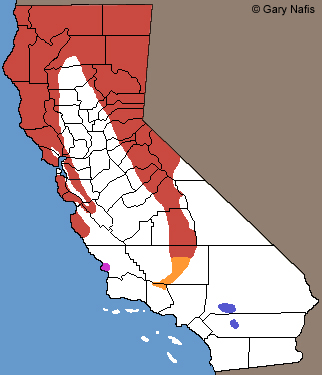
Red: Charina bottae - Northern Rubber Boa
Blue: Charina umbratica - Southern Rubber Boa
Orange: area where the species of rubber boa
is recognized as potentially C. umbratica by the CDFW.
Purple: Area representing recently-discovered
boas of unexamined species, most likely C. bottae.

Not Dangerous (Non-poisonous) Rubber Boas do not have venom that is dangerous to most humans. |
||
| Rubber boas are thick-bodied, blunt-tailed, slow-moving snakes found in moist areas in grassland, chaparral, woodland, and forest. Active on the surface mostly at night, often at low temperatures for snakes. Usually found crossing roads at night and under surface objects such as rocks, logs, and boards. Adults are brown, gray, tan or olive in color. Some juveniles are bright pink or orange. Two species occur in California. Check the range map to determine which one occurs in your area. |
||
| Rubber Boa - Charina bottae | ||
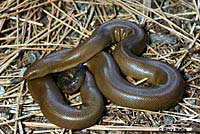 |
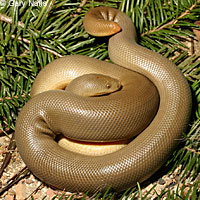 |
 |
| Adult | Adult | Juvenile © Jackson Shedd |
| Southern Rubber Boa - Charina umbratica | ||
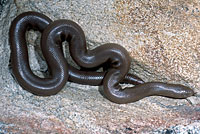 |
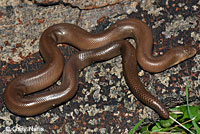 |
 |
| Adult | Adult | Juvenile |
Morphological Traits To Help Differentiate Charina bottae and Charina umbratica * |
||
| (These traits are generally accurate, but they do not always apply exactly to every specimen.) There is no easy way to separate these two species without counting dorsal and ventral scales. To add further complications, boas from the Tehachapi Mountains and Mt. Pinos resemble C. umbratica in having low middorsal and ventral scale counts, but they tend to be more like C. bottae from the more northern localities in the frontal scale character. |
||
| Charina bottae 42 or more middorsal scale rows 197 or more full-sized ventral scales Frontal scale - subtriangular with a distinctly convex or angular posterior margin |
||
| Charina umbratica 41 or fewer middorsal scale rows 196 or fewer full-sized ventral scales Frontal scale - subrectangular with a straight or only slightly convex or angular posterior margin |
||
 |
||
Differences in general shape of head scales of Charina bottae and Charina umbratica, with some common scale anomalies that occur in either form, such as a partially divided frontal scale and a completely divided parietal scale. These anomalies cannot be used to diagnose the two forms. Arrows indicate anterior margin. F - frontal scale |
||
| Adapted from: Javier A. Rodriguez-Robles, Glenn R. Stewart, and Theodore J. Papenfuss Mitochondrial DNA-Based Phylogeography of North American Rubber Boas, Charina bottae (Serpentes: Boidae) Molecular Phylogenetics and Evolution Vol. 18, No. 2, February, pp. 227–237, 2001 |
||
Return to the Top
© 2000 -
